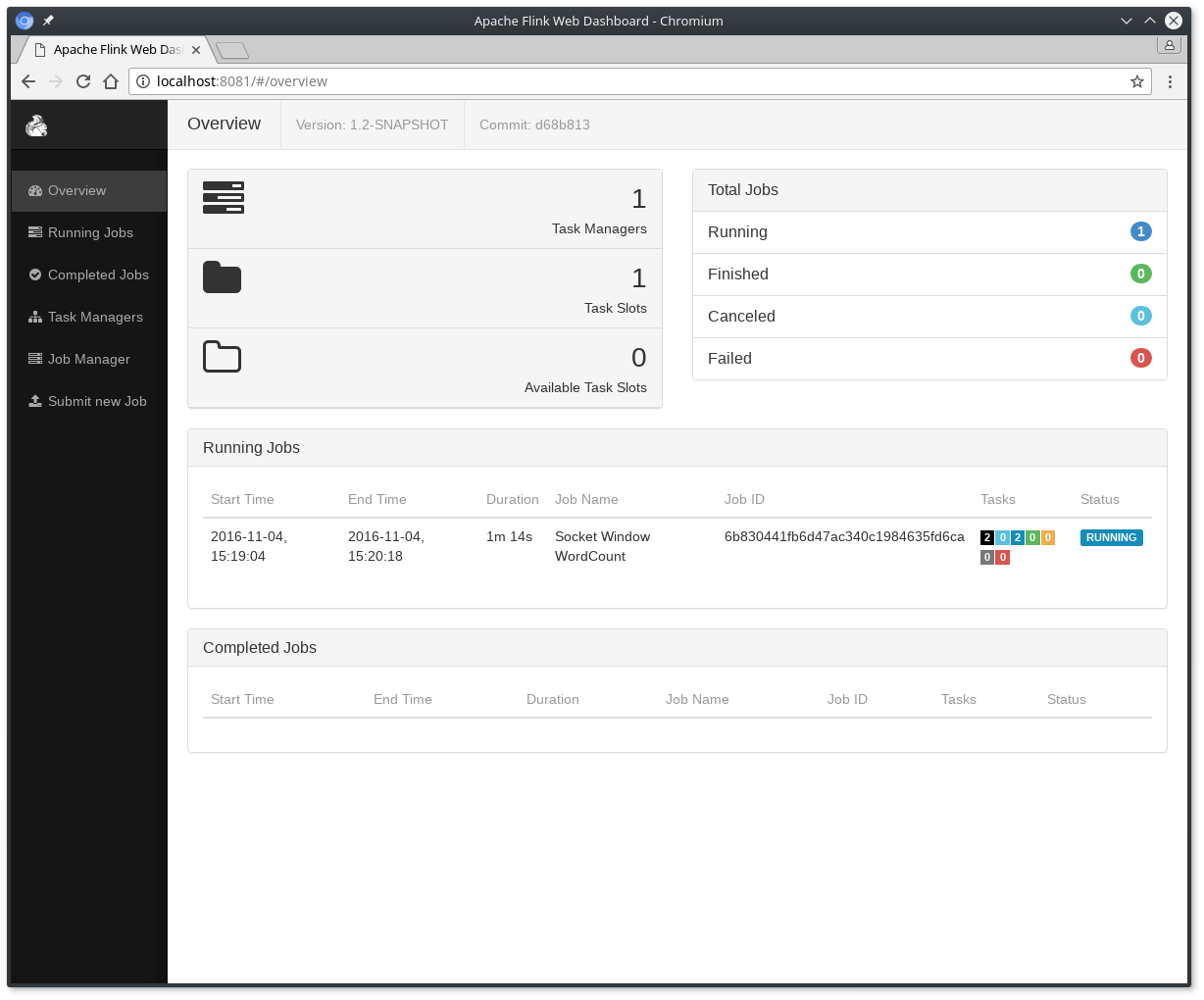初识Flink
Apache Flink是一个用于分布式流和批处理数据处理的开源平台。Flink的核心是流数据流引擎,为数据流上的分布式计算提供数据分发,通信和容错。Flink在流引擎之上构建批处理,覆盖本机迭代支持,托管内存和程序优化。
一、Flink 的下载安装启动
设置:下载并启动Flink
Flink可在Linux,Mac OS X和Windows上运行。为了能够运行Flink,唯一的要求是安装一个有效的Java 8.x. Windows用户,请查看Windows上的Flink指南,该指南介绍了如何在Windows上运行Flink以进行本地设置。
您可以通过发出以下命令来检查Java的正确安装:
java -version
如果你有Java 8,输出将如下所示:
-
java version "1.8.0_111"
-
Java(TM) SE Runtime Environment (build 1.8.0_111-b14)
-
Java HotSpot(TM) 64-Bit Server VM (build 25.111-b14, mixed mode)
-
$ cd ~/Downloads # Go to download directory
-
$ tar xzf flink-*.tgz # Unpack the downloaded archive
-
$ cd flink-1.7.0
二、启动本地Flink群集
$ ./bin/start-cluster.sh # Start Flink
检查web前端ui页面在http://localhost:8081,并确保一切都正常运行。Web前端应报告单个可用的TaskManager实例。
您还可以通过检查logs目录中的日志文件来验证系统是否正在运行:
-
$ tail log/flink-*-standalonesession-*.log
-
INFO ... - Rest endpoint listening at localhost:8081
-
INFO ... - http://localhost:8081 was granted leadership ...
-
INFO ... - Web frontend listening at http://localhost:8081.
-
INFO ... - Starting RPC endpoint for StandaloneResourceManager at akka://flink/user/resourcemanager .
-
INFO ... - Starting RPC endpoint for StandaloneDispatcher at akka://flink/user/dispatcher .
-
INFO ... - ResourceManager akka.tcp://flink@localhost:6123/user/resourcemanager was granted leadership ...
-
INFO ... - Starting the SlotManager.
-
INFO ... - Dispatcher akka.tcp://flink@localhost:6123/user/dispatcher was granted leadership ...
-
INFO ... - Recovering all persisted jobs.
-
INFO ... - Registering TaskManager ... under ... at the SlotManager.
三、阅读代码
您可以在Scala中找到此SocketWindowWordCount示例的完整源代码,并在GitHub上找到Java。
- Scala的
-
object SocketWindowWordCount {
-
-
def main(args: Array[String]) : Unit = {
-
-
// the port to connect to
-
val port: Int = try {
-
ParameterTool.fromArgs(args).getInt("port")
-
} catch {
-
case e: Exception => {
-
System.err.println("No port specified. Please run 'SocketWindowWordCount --port <port>'")
-
return
-
}
-
}
-
-
// get the execution environment
-
val env: StreamExecutionEnvironment = StreamExecutionEnvironment.getExecutionEnvironment
-
-
// get input data by connecting to the socket
-
val text = env.socketTextStream("localhost", port, '\n')
-
-
// parse the data, group it, window it, and aggregate the counts
-
val windowCounts = text
-
.flatMap { w => w.split("\\s") }
-
.map { w => WordWithCount(w, 1) }
-
.keyBy("word")
-
.timeWindow(Time.seconds(5), Time.seconds(1))
-
.sum("count")
-
-
// print the results with a single thread, rather than in parallel
-
windowCounts.print().setParallelism(1)
-
-
env.execute("Socket Window WordCount")
-
}
-
-
// Data type for words with count
-
case class WordWithCount(word: String, count: Long)
-
}
-
public class SocketWindowWordCount {
-
-
public static void main(String[] args) throws Exception {
-
-
// the port to connect to
-
final int port;
-
try {
-
final ParameterTool params = ParameterTool.fromArgs(args);
-
port = params.getInt("port");
-
} catch (Exception e) {
-
System.err.println("No port specified. Please run 'SocketWindowWordCount --port <port>'");
-
return;
-
}
-
-
// get the execution environment
-
final StreamExecutionEnvironment env = StreamExecutionEnvironment.getExecutionEnvironment();
-
-
// get input data by connecting to the socket
-
DataStream<String> text = env.socketTextStream("localhost", port, "\n");
-
-
// parse the data, group it, window it, and aggregate the counts
-
DataStream<WordWithCount> windowCounts = text
-
.flatMap(new FlatMapFunction<String, WordWithCount>() {
-
@Override
-
public void flatMap(String value, Collector<WordWithCount> out) {
-
for (String word : value.split("\\s")) {
-
out.collect(new WordWithCount(word, 1L));
-
}
-
}
-
})
-
.keyBy("word")
-
.timeWindow(Time.seconds(5), Time.seconds(1))
-
.reduce(new ReduceFunction<WordWithCount>() {
-
@Override
-
public WordWithCount reduce(WordWithCount a, WordWithCount b) {
-
return new WordWithCount(a.word, a.count + b.count);
-
}
-
});
-
-
// print the results with a single thread, rather than in parallel
-
windowCounts.print().setParallelism(1);
-
-
env.execute("Socket Window WordCount");
-
}
-
-
// Data type for words with count
-
public static class WordWithCount {
-
-
public String word;
-
public long count;
-
-
public WordWithCount() {}
-
-
public WordWithCount(String word, long count) {
-
this.word = word;
-
this.count = count;
-
}
-
-
@Override
-
public String toString() {
-
return word + " : " + count;
-
}
-
}
-
}
四、运行示例
现在,我们将运行此Flink应用程序。它将从套接字读取文本,并且每5秒打印一次前5秒内每个不同单词的出现次数,即处理时间的翻滚窗口,只要文字漂浮在其中。
- 首先,我们使用netcat来启动本地服务器
$ nc -l 9000
- 提交Flink计划:
-
$ ./bin/flink run examples/streaming/SocketWindowWordCount.jar --port 9000
-
Starting execution of program
程序连接到套接字并等待输入。您可以检查Web界面以验证作业是否按预期运行:
- 单词在5秒的时间窗口(处理时间,翻滚窗口)中计算并打印到
stdout。监视TaskManager的输出文件并写入一些文本nc(输入在点击后逐行发送到Flink):
-
$ nc -l 9000
-
lorem ipsum
-
ipsum ipsum ipsum
-
bye
该.out文件将在每个时间窗口结束时,只要打印算作字浮在,例如:
-
$ tail -f log/flink-*-taskexecutor-*.out
-
lorem : 1
-
bye : 1
-
ipsum : 4
要停止Flink你可以执行如下命令:
$ ./bin/stop-cluster.sh
文章来源: blog.csdn.net,作者:血煞风雨城2018,版权归原作者所有,如需转载,请联系作者。
原文链接:blog.csdn.net/qq_31905135/article/details/86649409
- 点赞
- 收藏
- 关注作者





评论(0)